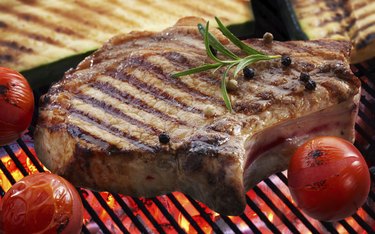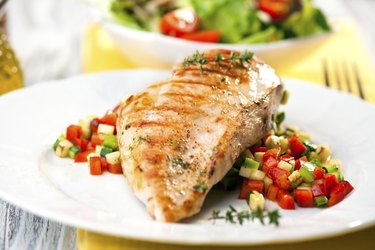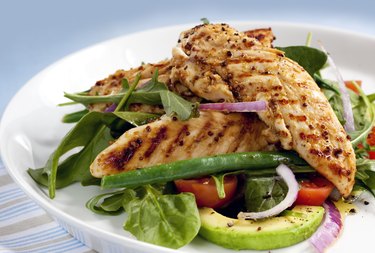
Choosing lean meats and skinless, unbreaded poultry helps keep your overall calorie intake low while meeting your daily protein needs. Most adults eat more than just a 1-ounce portion of meat or poultry. According to MedlinePlus, one serving size of meat or poultry is about the size of the palm of your hand or a deck or cards – which is about a 3-ounce portion.
Meat Cuts
Video of the Day

Leaner meats generally contain fewer calories than high-fat meats -- because while protein provides 4 calories per gram, fat contains 9 calories in each gram. According to the U.S. Department of Agriculture's National Nutrient Database for Standard Reference, 1 ounce of 90-percent-lean ground beef contains 92 calories, and a 1-ounce portion of boneless, lean pork loin provides just 37 calories.
Video of the Day
Poultry Counts

Eating skinless, unbreaded chicken or turkey is a low-calorie way to meet your daily protein needs. For example, the USDA reports that 1 ounce of chicken breast without the skin contains 34 calories, and lean turkey provides just 32 calories in each 1-ounce portion. But eating poultry with the skin or choosing breaded -- especially fried – poultry significantly increases the calorie content of your meal.
Health Considerations

High-fat meats are not only higher in calories but are generally rich in saturated fat and dietary cholesterol -- which significantly increases your heart-disease risks when you consume such meats in excess. Highly processed meats, such as sliced luncheon meats, are generally high in dietary sodium, which can increase your blood pressure. Therefore, choose lean cuts of poultry and meat with little fat marbling, and pick fresh or frozen meats and poultry instead of processed meats.
Protein Content

Almost all of the calories in lean meat and skinless poultry are from dietary protein. For example, 25 of the 37 calories in 1 ounce of lean pork loin are from protein, and 25 of the 32 calories in lean turkey are protein calories. Therefore, eating lean meats and poultry is an excellent way to meet your daily protein needs and control your overall calorie intake. The Institute of Medicine reports the recommended dietary allowance, or RDA, for protein is 46 grams for women, 56 grams for men and 71 grams of protein daily during pregnancy and lactation.
- MedlinePlus: Portion Sizes
- U.S. Department of Agriculture National Nutrient Database for Standard Reference: Beef, Ground, 90% Lean Meat / 10% Fat, Patty, Cooked, Broiled
- U.S. Department of Agriculture National Nutrient Database for Standard Reference: Pork, Fresh, Loin, Top Loin (Roasts), Boneless, Separable Lean Only, Raw
- U.S. Department of Agriculture National Nutrient Database for Standard Reference: Chicken, Broilers or Fryers, Breast, Meat Only, Raw
- U.S. Department of Agriculture National Nutrient Database for Standard Reference: Turkey, Whole, Meat Only, Raw
- Institute of Medicine: Dietary Reference Intakes: Macronutrients